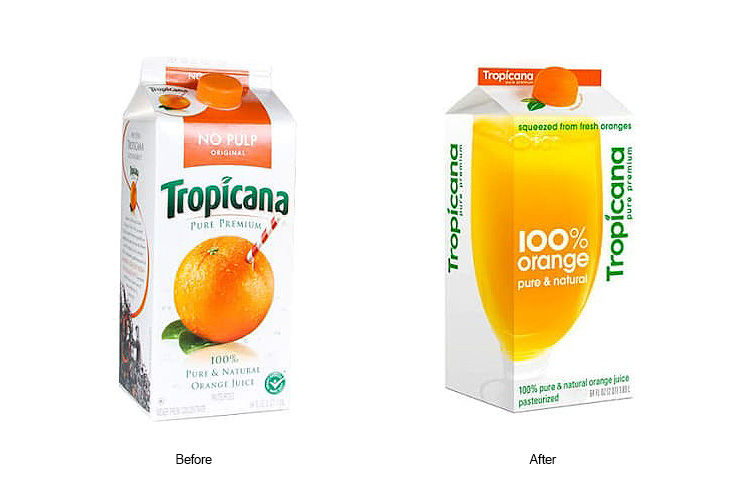Henry Ford famously quipped, “You can have any color you want, as long as it’s black.” While it worked for the Model T in its heyday, today’s consumers demand more. Branding is how a company distinguishes itself, creates an emotional connection, and ultimately, drives business results. But how do you know if a hefty rebranding investment is truly paying off?
Consider the case of Tropicana. In 2009, the iconic orange with a straw logo underwent a radical redesign. The new packaging featured a sleek glass of juice and a modernized font. The backlash was swift. Consumers found the new design generic and confusing. Sales plummeted an estimated 20% in just two months, prompting the company to quickly revert to its familiar orange-centric packaging.
The Tropicana debacle reveals a critical truth: A rebrand is about far more than a fresh coat of visual paint. Successful rebranding goes deeper, impacting metrics that matter to your bottom line.

The Challenge of "Subjective" Success
While a sense of renewed energy and positive feedback are good indicators, comments about the brand feeling “more modern” or “appealing” don’t translate into measurable results that demonstrate the value of a significant investment. Let’s see how we can go beyond initial subjective impressions.
Why Proving Rebranding ROI Matters
- Data-Driven Decision Making: Quantifying the results of your rebrand provides invaluable insights, helping you refine your brand strategy, make informed marketing investments, and maximize future growth.
- Demonstrating Branding's Value: Hard data transforms branding from a subjective expense to a strategic business driver. This elevates the role of branding within your organization and secures ongoing support.
- Aligning Stakeholders: A clear demonstration of ROI aligns internal teams and executives around the long-term benefits of brand investment, fostering collaboration and a shared sense of purpose.
The Data-Driven Approach to Measuring Success
The key is to define what success looks like embarking on the rebranding journey. Here’s a deeper dive into areas to focus on:
Financial Performance
- Sales Growth & Revenue Trends: Analyze sales data over time to identify post-rebrand growth and potential revenue increases. Account for external factors by comparing year-over-year results and using industry benchmarks.
- Customer Profitability: Track changes in the average profit margin per customer and overall customer lifetime value (CLV). A successful rebrand can attract higher-paying customers who are loyal and engaged for longer periods.
- Pricing Power: Assess whether your rebrand allows you to command higher prices due to increased brand value and perceived quality.
Brand Perception and Awareness
- Brand Equity Research: Conduct pre- and post-rebrand studies to measure changes in how your ideal customers perceive your brand. Focus on core attributes like trustworthiness, innovation, and the overall customer experience.
- Social Listening & Sentiment Analysis: Monitor social media conversations, online reviews, and mentions across the web to gauge overall sentiment towards your brand and track changes over time.
- Website Analytics & Search Trends: Analyze increases in website traffic, time-on-site, conversion rates, and search volume for branded keywords. This indicates growing brand awareness and interest.
Competitive Position and Reach
- Media Coverage & Share of Voice: Track press mentions, industry awards, and analyst reports. Measure your share of voice compared to key competitors to see how your visibility and influence evolve after the rebrand.
- Target Audience Expansion: Examine if your rebrand successfully attracts new customer segments (demographic or psychographic), opens up new markets, or expands your presence globally.
- Partner & Investor Interest: A strong rebrand can attract potential strategic partnerships, investors, and favorable funding opportunities due to increased brand value.
Internal Impact
- Employee Engagement & Retention: Measure employee satisfaction before and after the rebrand. A compelling brand can boost morale, reduce turnover, and turn employees into passionate brand ambassadors.
- Talent Acquisition: Monitor changes in the number and quality of job applicants. A strong employer brand attracts top talent and can reduce recruitment costs.
Case Study in Action

One of the most iconic rebranding success stories is undoubtedly Old Spice. Founded in 1938, Old Spice was a well-known but unfashionable men’s deodorant brand, often associated with an older demographic. Suffering from declining sales, the brand decided on a radical shift. Their bold rebranding campaign, centered around humorous commercials and the now-famous “The Man Your Man Could Smell Like” tagline, completely revitalized their image. This rebranding wasn’t simply about appearances; it tapped into a broader cultural shift and resonated with a younger audience.
The results were staggering: within six months of launching the campaign, Old Spice saw a 107% increase in sales. This case study is a testament to how a strategic, data-driven rebrand can revitalize a struggling brand and increase market share significantly
Key Takeaways
- Define your goals beforehand: Are you aiming to attract new customers, reinvigorate sales, or boost employee loyalty? Clearly define your success metrics from the outset.
- Data reigns supreme: Use analytics tools to track relevant data before, during, and well after the rebrand. It's in the long-term trends that you see the true ROI.
- Don't neglect "soft" metrics: While hard data is essential, also consider the subjective, but important feedback from customers, employees, and stakeholders to gain a holistic view of impact.
Remember: Rebranding is an Investment
While the Tropicana story is cautionary, countless companies have reaped huge rewards from strategic rebrands. Think of Apple’s evolution from a niche computer company to a global lifestyle brand or Burberry’s transformation from a stodgy outerwear company to a luxury fashion powerhouse.
A rebrand is an investment in the future of your company. By tracking the right metrics and embracing both quantitative and qualitative data, you’ll be able to confidently demonstrate the value your rebranding efforts bring to your business.



